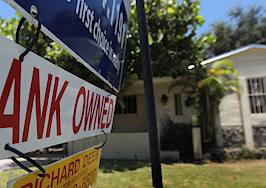For bargain-hunting buyers, low-priced fixers are irresistibly tempting. Often, these “bargain” listings are sold strictly “as is.” So, make sure your buyers keep these nine factors in mind when they’re searching for “the one.”
1. Expect trouble
Contractors or investors with crews on standby likely know what they’re getting into. But for newbie investors — or clients who’ve watched a few too many HGTV home renovation shows — “buyer beware” has never been more crucial.
Maybe that fixer is grandma’s house. Grandma is living it up in Arizona, and her adult kids just want it gone. Maybe the owners have to sell their home short or lose it to foreclosure. Or the sellers could be skinflints who refuse to spend money on updates they won’t be around to enjoy.
All are good reasons to sell as is. And none of them mean major structural issues or failed systems are behind the decision. But the odds of such listings being mere cosmetic fixers are not nearly as high as your buyers probably hope.
2. Line up property information resources in advance
To land unicorn-rare true bargains, buyers must act fast. Acting fast without solid information is the top shortcut to disaster — which you want to help your clients avoid.
An escrow officer who can quickly produce title histories and pinpoint red flags on the deed, varied inspectors standing by to evaluate structures on short notice, and contractors who can provide solid estimates on needed repairs quickly allow buyers to act fast with a clearer picture of what fixes will be required.
Do forewarn clients that no inspector can open walls, so even the best inspections can’t find hidden issues. Those things are what contingency funds are for.
3. Money talks
Ideally, your bargain-hunting buyers will have cash to entice sellers with quick, almost guaranteed closings. Loan carrying costs add significantly to the hard costs that must be covered before a flip becomes even remotely profitable, so you might want to remind newbie homebuyers who plan to get loans that time is money.
Then connect them with a savvy lender who can wrap remodeling costs into their mortgage — and be another voice of reason.
4. Remember location, location, location
Yes, the neighborhood and its closeness to any town’s top amenities are still primary factors in property selection. But other location specifics are crucial, too. That’s where the buyers’ chosen title officer comes in. Before they even go look at a prime purchase prospect, buyers should ask their title officer to pull reports so they:
- Can make sure the property’s zoning suits them
- Are aware of any special tax or historic districts affecting the property
- Can verify the property is not in a flood zone or industrial area, or — if it’s outside a sewer district — that it is in an area that will support a well or septic system
5. Hope for paradise, prepare for a jungle
COVID-19 has ushered in all new standards for personal protective garb at real estate showings. But in addition to covering themselves in masks, gloves and shoe covers (and plying on the hand-sanitizer), buyers of as-is properties should dress for a backcountry hike. Sturdy clothing, gloves and flat shoes or boots are mandatory.
Also recommend tetanus shots.
6. Be ready to fix whatever that nasty smell is
Many of the as-is listings you visit will have a funky odor. Best case, the house smells like it’s been closed up for decades. Worst case, the odor is a mix of dry rot, termites, cigarette smoke, animal droppings and rotted food. Garbage and dung are the least of your buyers’ worries in worst-case properties.
Water damage can, of course, be fixed. But the source of the water incursion can be the very devil to find and mitigate. And, the smell of wood rot lingers. Tobacco smoke leaves a nasty film on every surface and can be nearly impossible to clean off, which must occur before painting.
Termite infestations can be expensive to stop and damage more costly to repair. Cat pee is in a class by itself. Buyers should be prepared to tear out and replace urine-soaked walls and floors to get rid of that smell.
7. Chase down the reasons
In addition to dry rot and termite damage, the underpinnings of the house can be weakened by previous ill-advised remodels that compromised support beams. Or undetected past fire, flood or earthquake damage could have undermined the structure.
If your buyers tell inspectors that the floors feel bouncy (or the house stinks) and where they’ve picked up such sensory cues, their inspectors will be on the lookout for the reasons.
8. Look up, down and all around
Most people notice odors right away. Then, their focus shifts to what they can see at eye-level and below. Make sure buyers look up. Holes in the roof rarely provide sky views. But water falling through holes in the roof visibly stains the ceiling.
Looking up outside may also suggest a to-do list for an arborist. Getting estimates for outdoor work — including essential landscaping fixes — is just as critical as obtaining cost projections for structural and system repairs for the residence.
9. Home inspections cost a little but can save a fortune
Inspection costs have gone up. So, thrifty buyers sometimes think they can save money by skipping inspections. You should always educate bargain buyers in advance that as-is prices probably mean that only the most significant (and unforeseen) repair costs can be used to renegotiate an already low selling price. So, paying $1,000 in inspection fees is the smart way for buyers to avoid purchasing a property that might cost 50 to 100 times that to get into habitable condition.
Tom Hanks and Shelly Long starred in a 1986 movie called The Money Pit. People still use that term for properties that unsuspecting buyers pour endless streams of money into. The movie was a comedy. In real life, money pits are so not. Make sure your buyers aren’t actors in a real-time remake, and you’ll be a big star.
Nicole Solari is owner and managing broker of The Solari Group in Solano and Napa Counties in Northern California. Nicole runs one of the highest producing brokerages in all of Northern California.








